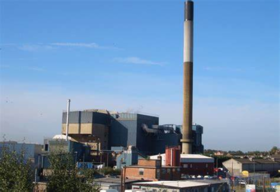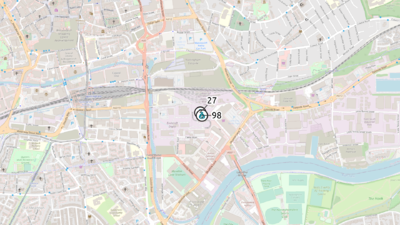Eastcroft EfW (Lines 1 & 2): Difference between revisions
m add picture and link |
m →Plant |
||
| Line 19: | Line 19: | ||
The plant was built in the early 1970's and as such information on the contractor and the technology used at the time is scarce. | The plant was built in the early 1970's and as such information on the contractor and the technology used at the time is scarce. | ||
Eastcroft comprises of 2 lines using standard combustion technology capable of treating 160,000 tonnes per annum. This process generates 180,000 MW of high pressure steam which is | Eastcroft comprises of 2 lines using standard combustion technology capable of treating 160,000 tonnes per annum. This process generates 180,000 MW of high pressure steam which is piped to the Enviroenergy district heating system on London Road, Nottingham where the turbines are housed to create electricity.<ref name="EC">https://www.nottinghampost.com/news/nottingham-news/turning-thousands-tonnes-rubbish-clean-3674962</ref> | ||
The remaining water, which is no longer boiling but is still warm, is then pumped around the city to be used for central heating. <ref name="EC" /> | The remaining water, which is no longer boiling but is still warm, is then pumped around the city to be used for central heating. <ref name="EC" /> | ||
Revision as of 15:19, 27 February 2020

| Eastcroft EfW (Lines 1 & 2) Operational | |
 See Residual EfW → page for a larger UK Wide map. | |
| Waste Licence | EP3034SN |
| Operator | FCC Environment (WasteNotts) |
| Region | East Midlands |
| Operational Capacity | 200ktpa |
| Is site R1? | fal |
| When was R1 Granted? | |
| What was the R1 value | 0.00 |
| Electrical Capacity | 9.00MWe |
| Number of Lines | 2 |
| Number of Turbines | 0 |
| CHP | Yes |
| Technology Approach | EfW |
| Funding Type | PPP |
Operators Annual Report
Input Data
| Year | HH | C&I | Clin | RDF | Total |
|---|---|---|---|---|---|
| 2016 | 162540.71 | 7303.29 | 0.00 | 0.00 | 169844.00 |
| 2017 | 143359.81 | 7323.15 | 0.00 | 0.00 | 150682.95 |
| 2018 | 167348.47 | 9248.53 | 0.00 | 0.00 | 176597.00 |
| 2019 | 188117.00 | 96.00 | 0.00 | 0.00 | 188213.00 |
| 2020 | 191092.00 | 10.00 | 0.00 | 0.00 | 191102.00 |
| 2021 | 166944.00 | 19059.00 | 0.00 | 0.00 | 186003.00 |
| 2022 | 161633.00 | 20515.00 | 0.00 | 0.00 | 182148.00 |
| 2023 | 164628.00 | 20659.00 | 0.00 | 0.00 | 185287.00 |
Output Data
| Year | IBA | IBA %ge of Tot IN | APC | APC %ge of Tot IN |
|---|---|---|---|---|
| 2016 | 34403.24 | 20.26% | 4911.14 | 2.89% |
| 2017 | 29304.00 | 19.45% | 3899.00 | 2.59% |
| 2018 | 35312.00 | 20.00% | 4488.00 | 2.54% |
| 2019 | 36654.00 | 19.47% | 4728.00 | 2.51% |
| 2020 | 37544.00 | 19.65% | 4400.00 | 2.30% |
| 2021 | 36250.00 | 19.49% | 4194.00 | 2.25% |
| 2022 | 34259.00 | 18.81% | 3926.00 | 2.16% |
| 2023 | 35400.00 | 19.11% | 4338.00 | 2.34% |
Summary
An EfW facility based upon conventional combustion technology which is not considered an ERF as a result of not having R1 status. Eastcroft has a permitted operational capacity of 160,000 tonnes per annum. It is operated by FCC Environment on behalf Nottingham City Council and Nottinghamshire County Council who took over the operation of the plant in 1998. Delivery of waste is by road from a network of waste transfer stations and the facility processes primarily residual Household Waste and some Commercial Waste.
The energy recovery process at Eastcroft generates steam, which is delivered via a pipeline to EnviroEnergy Limited, a company wholly owned by Nottingham City Council. EnviroEnergy supplies heat to a wide range of customers, including 4,600 domestic premises in the city, as well as public buildings including the Broad Marsh shopping centres, Victoria Baths, Nottingham Trent University’s Newton Building, the Inland Revenue building, the Magistrates Court, Nottingham City Council offices and the National Ice Centre. Any excess steam is also used to generate electricity which powers the facility and is also supplied to many local customers within Nottingham City.[1]
History
The Eastcroft facility was built primarily to service a 25 year PPP with Nottinghamshire County Council and Nottingham City Council and became operational in 1973. It was built to treat around 150,000-160,000 tonnes per annum of residual Household Waste and some Commercial Waste throughout Greater Nottinghamshire.
During the 1990's it was upgraded to meet the emission standards imposed by the Environmental Protection Act 1990 (EPA) and European Directive on Integrated Pollution Prevention and Control 96/61/EC.
FCC Environment have also received planning consent to add an additional line to the facility at Eastcroft which will see the total amount of Residual Waste treated on site increased by a further 100,000 tonnes per annum taking the total tonnage capacity to 260,000 tonnes being treated over 3 lines. Eastcroft EfW (3rd Line) (re-submission) contains further details of this expansion.
Plant
The plant was built in the early 1970's and as such information on the contractor and the technology used at the time is scarce.
Eastcroft comprises of 2 lines using standard combustion technology capable of treating 160,000 tonnes per annum. This process generates 180,000 MW of high pressure steam which is piped to the Enviroenergy district heating system on London Road, Nottingham where the turbines are housed to create electricity.[2]
The remaining water, which is no longer boiling but is still warm, is then pumped around the city to be used for central heating. [2]
Back in the early 1970s linking an energy from waste facility with district heating was the biggest of its kind in the UK costing in the region of £5m.[2]
Local Authority Users
The following data comes from WasteDataFlow for the financial year 2018/19 and represents those local authorities recorded as putting tonnage into the site (either directly or via a transfer station). The tonnage received cannot be directly compared with the stated historical tonnage received and recorded in the EA statistics as these are recorded on a calendar year basis (i.e. January 2018 to December 2018). A 'zero return' below indicates no local authority tonnage was recorded, most likely a result of the plant being recently commissioned and actually having received no tonnage. Equally, lower than expected tonnage maybe a result of either a new plant being in 'ramp up' towards full capacity after construction, or may be a result of plant shut down and subsequent re-start in a year.
| Authority | Tonnage |
|---|---|
| Derby City Council | 2096.030 |
| Derbyshire County Council | 6439.780 |
| Nottingham City Council | 90060.030 |
| Nottinghamshire County Council | 74413.160 |
| Rutland County Council | 9350.640 |
